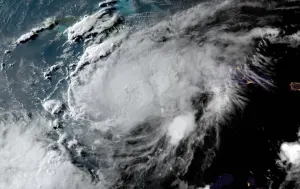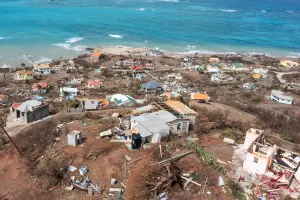
Lack of sea ice in the Gulf of St. Lawrence means more seals on shore
It's not unusual for the Marine Animal Response Society to get more calls about seals on beaches this time of year.
But with record-low ice levels in the Gulf of St. Lawrence, the Nova Scotia-based conservation society is seeing an even greater increase than normal in the number of calls in Cape Breton, Prince Edward Island and New Brunswick.
"There's not as much ice for the seals to relax and rest on, so they're coming ashore more often now and being more visible to the public," said Danielle Pinder, a hotline operator and primary responder with the group, known as MARS.
This year's total ice cover is only 4.2 per cent in the Gulf of St. Lawrence. Typically, that number hovers around 33 per cent.
MARS responds to reports of marine animals in distress to provide help where possible, and investigates the cause of death for those found dead, as a part of its mandate for research and conservation.
Pinder said the calls they receive about the seals cover a variety of concerns.
"Sometimes we get seals that have wandered into a little bit of a dangerous situation or get some wandering across roads or into fields," said Pinder.
She said over the years they've found seals as far as five kilometres from the sea, and one that wandered into a blueberry field.
"Other times (callers) are just concerned that maybe there's a pup on a beach and the mom might have abandoned it, or the seal looks injured or maybe it just needs assistance," she said.
That's why MARS recommends calling the organization first and giving as much information as possible so operators can determine whether the seal needs help or is just having a rest.
Pinder said seals come ashore for a variety of reasons, such as to have their first molt or to leave a pup so they can go offshore to feed. Some seals give birth on land. Others that normally give birth on the ice now have no choice but to come ashore.
"It's very critical that they actually do have time on land and they can be in one spot for a long time, days, up to a week at a time, really."

A healthy seal seen in Dartmouth, N.S. (Submitted to the CBC by the Marine Animal Response Society)
IDENTIFYING A HEALTHY SEAL
A healthy seal will look well fed, according to Pinder: "We definitely want to see seals that look nice and plump and fat."
They will usually be alert but could also be sleeping, which some people mistake as lethargic. A healthy seal will likely bark or hiss if approached.
Seals can also spend their time in a variety of postures, all of which are healthy, including lying on their side with a flipper high in the air or arching their back with their head and back flippers in the air in the shape of a banana.
Pinder said many people also believe if a seal is shivering, it's a bad sign, but it's just a part of how the animal regulates its temperature. Shivering can also be a sign of stress in response to humans.

A harbour seal out on the ice. (Submitted to the CBC by Marine Animal Response Society)
SEALS IN DISTRESS
If a seal has very deep wounds, or seems to be entangled with plastic, rope or marine debris, that can be a problem. It's also issue if a seal is somewhere dangerous like a roadway.
It's a sign something might be wrong if a seal is very thin and its neck, hips or ribs are visible.
A P.E.I. government spokesperson said in an email Wednesday that there had been nine seal calls in the week prior. Seven pups were released alive, two did not survive. The spokesperson said more calls are expected as pups are most active in February and March.
Although seal pups are usually left alone for quite a while, it can be a concern if the mother has been gone for several days. In that case, Pinder said not to approach the pup yourself but gather as much information as possible from a distance and then report it. Pups that have been handled by humans before they're weaned face a greater chance of being abandoned by their mothers.
"Again, some of these bad signs don't necessarily indicate that a seal is immediately in trouble," said Pinder. "It just means that we want to monitor it more closely to see if it does eventually need assistance."
Pinder said the loss of sea ice is concerning for the safety of the animals and because the public is now interacting with seals more frequently.
She advises seal-watchers to keep their distance, not just for the good of the seals but also because they bite and can carry disease that is able to transmit to humans.
"You can take photos, but maintain your distance and call the hotline if there's anything that seems concerning," said Pinder. "It's actually illegal under the Marine Mammal Regulations for anyone to disturb, harm, touch or move these animals."
This article was written for the CBC by Brittany Wentzell.









